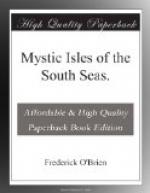“We ate for three days,” he related to me. “More than two hundred and fifty swine, fifteen hundred chickens, and enough fish to equal the miraculous draft on the shores of Galilee. We Polynesians were always that way, Gargantuan eaters at times, but able to go fifty miles at top speed on a cocoanut in war.”
Tati would have me stay indefinitely his guest, but I had written to Mataiea of my intended arrival there, and though there were insistent cries that I return soon, I said farewell.
Tati himself walked with me to the bridge over the Taharuu River, one of the hundred and fifty streams I crossed in a circuit of Tahiti.
“My ancestor, the old chief Tati,” he told me, “cut down the sacred trees of our clan marae near by, the aitos, tamanus, and miros. He had become a Christian, as was fashionable, and at the instigation of the English missionaries destroyed many beautiful and ancient trees, statues, carvings, and buildings. The Tahitians who mourned his iconoclasm had a chant which said that the Taharuu River ran blood when their gods were dishonored.”
From the stream the vast domain of the plantation of Atimaono stretched to Mataiea. It had been planted in the sixties, when British demands for cotton, and the blockade and laying waste of the South in the American Civil War caused a thousand such speculations all over the world.
It was for this plantation, the most celebrated in Tahiti, that Chinese were imported, and a thousand had their shanties where now is brush. Those were the times that the Marquesas had their cotton boom, and lapsed, too. Upon a hill of this plantation the English manager, a former cavalry officer, had built himself a palatial mansion, and lived like a feudal lord, the most powerful resident of Tahiti. Travelers from all the world were his guests. Fair ladies danced the night away upon his broad verandas and drank the choicest wines of France. Scandal wove a dozen strange stories of intrigues, of a high official who sold his wife to him, of Arioian orgies, and all the associations of semi-regal rule and accountability to none. Cotton prices declined, the bubble burst in bankruptcy, the miserable death of the aristocrat, and the fury of cheated English investors.
The plantation was now owned by a storekeeper of Tahiti, prosy and disliked, who had fattened by ability to outwit the natives; but the glory had departed, and the place languished, ruins and jungle, the prey of guava and lantana. The neighborhood was known as Ati-Maono, “The Clan of Maon.”
The lines between village and country were not rigid, and often the hamlet straggled along the road for much of the district. Every kilometer there was a stone marking the distance from Papeete. One knew the villages more by the Chinese stores than by any other feature.
“You will find the Papara country full of oranges,” Fragrance of the Jasmine had said.
The fruit was as sweet and delicious as any I had eaten, and the trees larger than their parents of Sydney, Australia. I strolled along the road eating, speaking all who passed or were in sight within their gardens, and came to Mataiea, where I was to live months and to learn the Tahitian mind and language.




